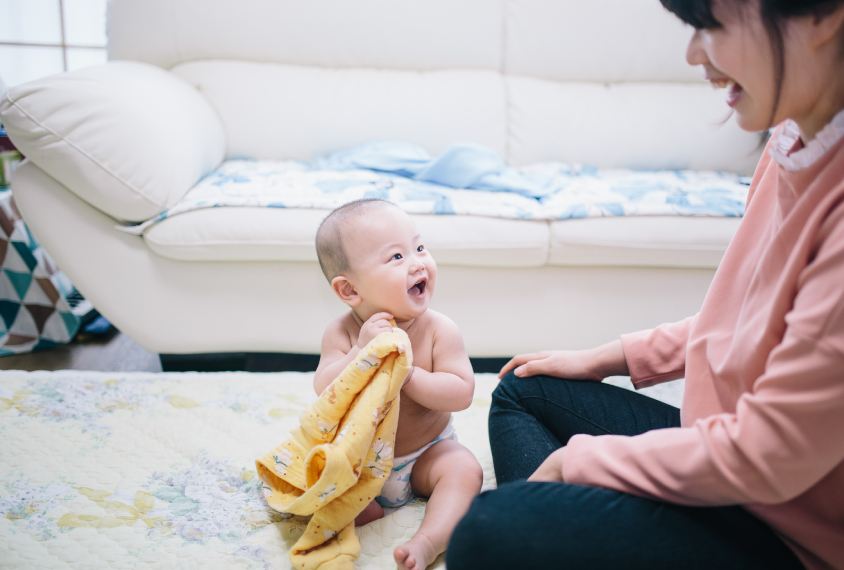
Insung Jeon / Getty Images
THIS ARTICLE IS MORE THAN FIVE YEARS OLD
This article is more than five years old. Autism research — and science in general — is constantly evolving, so older articles may contain information or theories that have been reevaluated since their original publication date.
A questionnaire that parents fill out may flag autism in 6-month-old babies, new research reveals1.
The questionnaire, called the Autism Parent Screen for Infants, asks parents to rate their infants on certain skills, such as imitating an adult or following visual cues. This information could help clinicians to identify children with autism more than two years before the condition is typically diagnosed.
The screen is not a diagnostic test. Some children flagged by the screen may not have autism, and some who aren’t flagged could have it. But screening children early on gives clinicians and parents the opportunity to boost certain skills during a crucial time in development, says lead researcher Lonnie Zwaigenbaum, co-director of the Autism Research Centre at the University of Alberta in Canada.
“Our group and others really feel that it’s a critical interval to be offering support and intervention,” he says.
The study, published 21 December in Autism, focuses on younger siblings of children with autism. These so-called baby sibs are 20 times more likely to have autism than children in the general population. Researchers are studying baby sibs to find early signs of autism, says Deborah Fein, professor of psychology at the University of Connecticut.
Some studies have shown that 6-month-old baby sibs later diagnosed with autism tend not to follow the eyes of an actor in a video. But assessing this skill requires eye-tracking technology, making it impractical for most clinics. The parent questionnaire “fills a niche, which is really needed,” Fein says.
It is unclear whether the questionnaire would help clinicians spot signs of autism in children who are not at increased risk, she says.
Early signs:
The study included 66 baby sibs later diagnosed with autism, 138 baby sibs who did not receive a diagnosis, and 79 controls with no family history of the condition. Parents filled out the questionnaire every three months, from as early as 6 months of age until 18 months. They completed the questionnaire again when their child turned 2. Clinicians assessed the children for autism at age 3.
The researchers found that baby sibs later diagnosed with autism scored higher on the questionnaire at every age than baby sibs without autism or typically developing controls. A score of 15 or above correctly predicted an autism diagnosis for roughly two-thirds of the baby sibs at 6 months old. It yielded a false positive for 14 percent of this group.
Infants later diagnosed with autism differed the most from the other children on questionnaire items probing the ability to imitate an adult, to take turns making sounds, share interests with others and visually track an object. It is unlikely that clinicians would see many of these behaviors during a 20-minute assessment, so parents may be in a better position to document them, Zwaigenbaum says.
An independent study, published 2 February in the Journal of Pediatrics, showed similar findings. The researchers found that baby sibs who have autism respond less to their names at 9 months of age and after than do either baby sibs without the condition or controls2.
Parents know best:
The fact that parents answer the questionnaire in real time makes it especially valuable, says Zwaigenbaum. One difficulty with questionnaires that rely on parents’ recall is that parents may not have known which subtle signs of autism to look for, Zwaigenbaum says.
The questionnaire also helps parents who may know something seems different about their child but struggle to convey this to a clinician. “This is another vote of confidence for parents and their observational skills,” Zwaigenbaum says. “[A screen] provides a common vocabulary for the parents and the clinicians, and it may encourage the clinicians to take things more seriously.”
The results may not extrapolate to the general population. Parents who already have one child with autism are likely to be acutely aware of the condition’s features.
“I think, in general, one should be very cautious about extrapolating findings from high-risk [children] to the full community,” Zwaigenbaum says. “But I think it’s a real opportunity to take this measure and see whether it might be predictive in the low-risk context as well.”
Zwaigenbaum and his team plan to partner with a network of pediatricians to see how well the questionnaire works in a broader group of children. They are also interested in seeing whether it can detect early signs of autism in children with conditions that often co-occur with autism, such as fragile X syndrome.
By joining the discussion, you agree to our privacy policy.